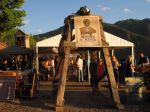SWEETS FOR THE HOLIDAYS
Something about the cold weather and holidays always gets me in the mood for a good dessert wine. I’ve discovered a few that I am looking forward to helping me get through the holidays and the rest of winter.
Port
Although I enjoy Port all year long, there is something about cold weather that gets me thinking about stocking up on this special dessert wine from Portugal’s Douro River Valley. The warming quality of Port’s intensity and high alcohol really hits the spot this time of year. There are many styles and a number of special designations but the wines are so good, the little extra effort it takes to understand them will be greatly rewarded. Actually, there are two basic styles: mostly wood-aged Port, usually classified as Tawny; and mostly bottle-aged Port, including Vintage, Late Bottled Vintage and Ruby.
Vintage Port is made only in exceptional years from the finest grapes in the top vineyards. They are dark, with intense fruit, great depth, and tannic grip. They also are quite expensive. Since I can’t afford Vintage Port often, one of my favorite alternatives is made by Ficklin Vineyards, a family operation that has been producing highly regarded California Port-style wines for three generations. The 1996 Ficklin Vintage Port ($36), though less intense than the Portuguese version, still is impressively rich and ready to enjoy immediately but will develop well.
Late Bottled Vintage Port (or LBV) also is an affordable alternative. It is made from good wines of a single year that didn’t quite make the cut for Vintage Port. Aged four to six years before bottling, it is ready to drink upon release but can last a few years. I enjoyed Dow’s 2007 LBV ($22), from the family’s fourth winemaking generation, for its full body and blackberry fruit balanced with good acidity and soft tannins.
Ruby Port is the youngest and most accessible Port. Aged three years in large vats to retain
freshness, expect straightforward, grapey fruit. Cockburn’s “Special Reserve” ($22), crafted to be more concentrated than a standard Ruby by this 200 year old producer, is a delectable choice with aromas of ripe plums and dark cherries and concentrated flavors to match. Fonseca Bin No. 27 ($21), another nearly two hundred year old family winery is quite intense with lively red fruits and good structure. Here again, Ficklin is a California alternative worth considering. I have been drinking the Old Vine Tinta Port ($18), which is produced using a unique solera blending system, for more than 30 years and it has never disappointed me.
Tawny Port is known less for power and concentration than for complexity, purity of fruit and finesse. Tawnies areblended wines and the best indicate an average age. Expect the balance, elegance and complexity to increase with the older wines. The Taylor Fladgate 20 Year Old ($56) is amazingly pure with vibrant, deep fruit, nutty complexity and great balance. The Fonseca 10 Year Old ($33) is quite fine in its own right and certainly more affordable, though a little sharper and not as complex. And don’t forget Ficklin’s Aged 10 Years ($28), which I enjoyed for its attractive plum and cinnamon and lingering finish.
Some California producers make a Port-style wine often using zinfandel because of its
ability to develop naturally high alcohol levels without fortification. The 2009 Dashe Late Harvest Zinfandel (375 ml, $24) certainly conjures the character of a Ruby Port. It has fine structure and acidity, with aromas and flavors of raspberry and black pepper. The 2009 St. Francis Sonoma County Port ($38) is a rich, blend of cabernet sauvignon, zinfandel, merlot, syrah, and alicante bouchet. Aromas of spice and dark fruits lead to exuberant wild berry flavors and a silky texture.
Banyuls
Where the south of France hugs the Mediterranean Sea, the Languedoc and the Roussillon produce a wide variety of sweet wines, mostly from variations of the white grape muscat and occasionally the red grape grenache. Most of these wines (known as Vin Doux Naturel) are made by fortifying the partially fermented wine with grape spirits. This report covers three of the best.
From the terraced vineyards near the seaside town of the same name, Banyuls, (grenache is the dominant grape) is a truly underappreciated sweet red wine. Since it is red and fortified, it is tempting to compare Banyuls to Port. But there are differences, such as lower alcohol and a slightly lighter style. A fine example comes from one of the estates of the Dauré family, one of the Roussillon’s leading producers. The 2009 Les Clos de Paulilles “Rimage” (500 ml, $25) does bear a resemblance to Vintage Port with its blackberry, cherry fruit and chocolate notes.
Muscat de Saint Jean de Minervois
Muscat de Saint Jean de Minervois is one of the most important muscat based Vin Doux Naturel. It comes from high altitude vineyards on an arid plain near the Languedoc community of the same name and north of the historic town of Narbonne. The wine is made with muscat blanc à petit grains, the best of the many muscat varieties. I found the nonvintage Les Petit Grains (375 ml, $14), from Les Vignerons de la Méditerranée (the growers association responsible for the good value Val d’Orbieu wines) to be a fine representative of the appellation. Its dramatic aromatics and fruit forward apricot, citrus and honey qualities are enticingly satisfying.
Muscat de Rivesaltes
In the Rousillon region, neighbor to the Pyrenees Mountains that form the border with Spain, Muscat de Rivesaltes is an appellation that accounts for most of France’s Muscat production. The Dauré family’s other estate, Château de Jau (which dates to 1792) is a standard bearer in the Rousillon and its Muscat de Rivesaltes is a fine example of the type. Although much Rivesaltes is made with the lesser muscat of Alexandria, the 2009 Chateau de Jau Muscat de Rivesaltes (500 ml, $25) is distinguished by the use of muscat blanc à petit grains. It is similar to the Les Petit Grains, though in a lighter, more refreshing style.
Sauternes
Many consider Sauternes the greatest of all sweet wines. The production zone is located just south of Bordeaux. This storied wine results from the marriage of late harvested semillon (with small amounts of sauvignon blanc or occasionally muscadelle), and the amazing “noble rot” known as botrytis cinerea. This leads to deeply concentrated juice that yields luscious nectar of a wine – honeyed, earthy and even a little spicy. For a great introduction to the wonders of Sauternes at a fair price, enjoy the 2008 Château de Cosse (375 ml, $25), This is the second wine of the great Château Rieussec. Yet it carries all of the qualities one would look for in fine Sauternes.
Tokaji Aszu
Although it is largely unknown among American consumers, Tokaji Aszu (pronounced TOE-keye-ee AH-zhu) is one of the greatest sweet wines on the planet. The Tokaj-Hegyalja region is about 150 miles northeast of Budapest, Hungary in the Zemplen Mountains at the confluence of the Tisza and Bodrog rivers. It is here, not France or Germany, where the first discovery of the botrytis cinerea (the “noble rot”) was documented over 400 years ago, when it was realized the juice from rotten grapes could produce an unctuous, sweet wine. Tokaji Aszu is crafted from indigenous grapes – primarily furmint, harslevelu and muscat blanc. Its unique production method involves blending a dry base wine with a sweet paste of aszu (the botrytis-infected grapes) in various proportions. The amount of residual sugar in the wine is ranked in levels ranging from 3 puttonyos up to 6 puttonyos. No surprise Tokaji Aszu became celebrated, favored by royal families throughout Europe. It’s rich, thick and refreshing because of the high acidity, with the flavors of dried apricots and oranges.
Today, the Royal Tokaji Wine Company, founded just in 1990, is the most important
producer of Tokaji Aszu and lucky for us the most readily available in America. These wines can be ridiculously expensive, so it is a real treat to find such quality at reasonably accessible prices. The 2007 5 Puttonyos “Red Label” (500 ml, $43) is a wine for superlatives. Amazingly luscious but lively, balanced and refreshing, you are likely to discern tropical, apricot, peach, and orange aromas and flavors. Intriguing hints of honey and earth cross the rich palate balanced with firming acidity. The 2009 Mád Cuvée Late Harvest (375 ml, $20) is made from vineyards near the town of Mád not far from Tokaj. It is lighter and fresher but definitely has a sense of richness – an excellent introduction to the style, exhibiting a fine balance between fruity sweetness and taut acidity.


















 four day visit to Germany’s Rhenhessen, Mosel and Nahe. I would say Mr. Groebe was the most traditionalist of all the growers we met. His wines are fermented in old wooden casks. And no screw caps here, he only uses cork (sustainably grown, of course) because it has a smaller carbon footprint. But others we met talked about using “integrated” approaches in the vineyard (spraying sulfur instead of pesticides, using compost instead of fertilizer). They may cut fruit to reduce yields and rely on the naturally occurring wild yeast to ferment the wine, yet use stainless steel tanks for fermentation.In the Rheinhessen, the flatter, rolling landscape is more conducive to organic practices. Many said they’re organic, though some admitted they weren’t certified. Actually, everyone we talked to professed to practice some level of sustainable agriculture.
four day visit to Germany’s Rhenhessen, Mosel and Nahe. I would say Mr. Groebe was the most traditionalist of all the growers we met. His wines are fermented in old wooden casks. And no screw caps here, he only uses cork (sustainably grown, of course) because it has a smaller carbon footprint. But others we met talked about using “integrated” approaches in the vineyard (spraying sulfur instead of pesticides, using compost instead of fertilizer). They may cut fruit to reduce yields and rely on the naturally occurring wild yeast to ferment the wine, yet use stainless steel tanks for fermentation.In the Rheinhessen, the flatter, rolling landscape is more conducive to organic practices. Many said they’re organic, though some admitted they weren’t certified. Actually, everyone we talked to professed to practice some level of sustainable agriculture. 




















 Of course, there wouldn’t be anything to write about without the amazing vineyards. And each grower showed a certain pride, even reverence for their vineyards. We especially heard a lot about slate – the layered, metamorphic rock of sedimentary, clay and sometimes volcanic origins notable for high mineral and crystalline content. These slate soils are prized for their ability to hold moisture and heat and to impart a distinctive sense of those minerals in the resulting wine.
Of course, there wouldn’t be anything to write about without the amazing vineyards. And each grower showed a certain pride, even reverence for their vineyards. We especially heard a lot about slate – the layered, metamorphic rock of sedimentary, clay and sometimes volcanic origins notable for high mineral and crystalline content. These slate soils are prized for their ability to hold moisture and heat and to impart a distinctive sense of those minerals in the resulting wine.











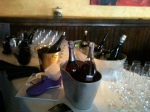 Next, it was off to Jimmy’s restaurant for a casual dinner hosted by Ferrer Wine Estates and featuringsome of their fine sparklers. While visiting with Eva Bertran, Executive Vice President at Freixenet USA, I enjoyed the Segura Viudas Reserva Heredad ($20) and Freixenet ElyssiaPinotNoir Brut from their extensive line of Cava. I also enjoyed talking and and tasting with Gloria Ferrer (the family’s California winery) winemaker Bob Iantosca. His limited release 2005 Anniversary Cuvee ($45) was especially complex and flavorful.
Next, it was off to Jimmy’s restaurant for a casual dinner hosted by Ferrer Wine Estates and featuringsome of their fine sparklers. While visiting with Eva Bertran, Executive Vice President at Freixenet USA, I enjoyed the Segura Viudas Reserva Heredad ($20) and Freixenet ElyssiaPinotNoir Brut from their extensive line of Cava. I also enjoyed talking and and tasting with Gloria Ferrer (the family’s California winery) winemaker Bob Iantosca. His limited release 2005 Anniversary Cuvee ($45) was especially complex and flavorful.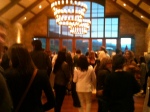 chef Jose Andres. Besidesgreat food, the event featured too many Spanish wines to taste them all or even keep tasting notes but I was impressed enough with the 2006 Bodegas Muga Reserva Seleccion ($40) to write it down in my notesand recommend it here. And that was just the first night! Friday night upped the ante.
chef Jose Andres. Besidesgreat food, the event featured too many Spanish wines to taste them all or even keep tasting notes but I was impressed enough with the 2006 Bodegas Muga Reserva Seleccion ($40) to write it down in my notesand recommend it here. And that was just the first night! Friday night upped the ante. At a reception hosted by importer Wilson Daniels, the array of fine winesfrom their international portfolio was truly impressive. I felt like a kid in a candy store, as there were numerous wines that impacted me, from white Burgundy (Leflaive 2008 Pulighy-Montrachet, Laroche 2009 Reserve de l’Obedience Chablis Grand Cru and 2009 Petite Chablis) and Rhone Valley whites (Tardieu Laurent 2007 Hermitage, 2009 Condrieu and 2007 Chateauneuf-du-Pape) to Barbaresco (2005 Ceretto Bricco Asili), Tokaji Aszu (1999 Royal Tokaji 6 Puttanyos), and California Cabernet Sauvignion (2008 Lancaster Estate). Whew!
At a reception hosted by importer Wilson Daniels, the array of fine winesfrom their international portfolio was truly impressive. I felt like a kid in a candy store, as there were numerous wines that impacted me, from white Burgundy (Leflaive 2008 Pulighy-Montrachet, Laroche 2009 Reserve de l’Obedience Chablis Grand Cru and 2009 Petite Chablis) and Rhone Valley whites (Tardieu Laurent 2007 Hermitage, 2009 Condrieu and 2007 Chateauneuf-du-Pape) to Barbaresco (2005 Ceretto Bricco Asili), Tokaji Aszu (1999 Royal Tokaji 6 Puttanyos), and California Cabernet Sauvignion (2008 Lancaster Estate). Whew!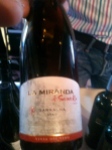 delectables with fine wines from Portuguese winery Esporao. My favorite at thistasting was the 2009 Esporao Reserva ($20), an enticing blend of indigenous and international varieties.
delectables with fine wines from Portuguese winery Esporao. My favorite at thistasting was the 2009 Esporao Reserva ($20), an enticing blend of indigenous and international varieties.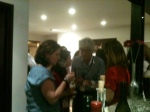

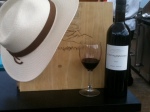 USA.This tasting featured just one wine, and an Argentinean wine at that: the 2007 Cheval des Andes ($80). This wine, a joint venture between Terrazas de Los Andes and Chateau Cheval Blanc, blends cabernet sauvignon, malbec and petite verdot into a wine that rivals the best of Bordeaux. It was so special it seemed perfectly appropriate that it was the only one at the tasting.
USA.This tasting featured just one wine, and an Argentinean wine at that: the 2007 Cheval des Andes ($80). This wine, a joint venture between Terrazas de Los Andes and Chateau Cheval Blanc, blends cabernet sauvignon, malbec and petite verdot into a wine that rivals the best of Bordeaux. It was so special it seemed perfectly appropriate that it was the only one at the tasting. Then it was to the reprise of the Kobrand happy hour. And what a treat it was to have a chance to taste many of the great Lousi Jadot Burgundies, wines even wine writers seldom get to taste. Just look at this line up! 1978 Chevalier Montrachet les Demoiselles1978 Bonnes Mares 1985 Gevrey Chambertin Clos St. Jacques 1986 Batard Montrachet 1989 Vosne Romanee Suchots 1990 Chambertin Clos de Beze 1991 Corton Charlemagne 1996 Beaune Greves 1996 Corton Pougets 1999 Meursault Genevrieres.
Then it was to the reprise of the Kobrand happy hour. And what a treat it was to have a chance to taste many of the great Lousi Jadot Burgundies, wines even wine writers seldom get to taste. Just look at this line up! 1978 Chevalier Montrachet les Demoiselles1978 Bonnes Mares 1985 Gevrey Chambertin Clos St. Jacques 1986 Batard Montrachet 1989 Vosne Romanee Suchots 1990 Chambertin Clos de Beze 1991 Corton Charlemagne 1996 Beaune Greves 1996 Corton Pougets 1999 Meursault Genevrieres.